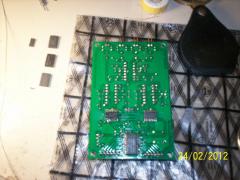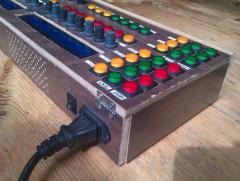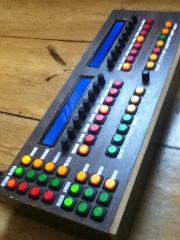
Gilesjuk
Members-
Posts
95 -
Joined
-
Last visited
Content Type
Profiles
Forums
Blogs
Gallery
Everything posted by Gilesjuk
-
They just plug in, there's plenty of room between the chips. There's no analogue filter in the SwinSID, so I don't think the filter capacitors are even needed. There's also no audio in, so you can't do the feedback mod. But then the SwinSID has some other tricks up its sleeve.
-
I imagine you could use the mechanism out of an old mouse (opto-mechanical) to do similar. The upside would be that the precision would be a lot higher and you wouldn't need to smash up so many hard disks. One mouse would be all that is needed. You would obviously need to pair each small roller up to a spindle which then connects to the "deck", with a couple of bearings for a smooth action. Some skateboard wheel cartridge bearings (maybe use the wheel to contain them? :)).
-
Sounds like the golden rule for fuses. If a fuse pops, don't replace it until you know why it popped.
-
SID and FM chips were a quantum leap in computer sound. Before SID it was all beeps (and afterwards too). FM provided better sounds, although we tend to think some of them are cheesy now. By the time sample playback became more popular it all got a bit dull and boring. Hence why nobody (to my knowledge) really builds things that play samples using old sample playback chips. The SID chip was more memorable than the Paula chip in the Amiga.
-
I'm curious, what does the older chip offer compared to OPL3? Are you after a more simple cheesy FM sound?
-
Many of them will end up in a skip or rubbish dump anyway. We at least salvage some less common parts in the process.
-
Every drum machine I've used has imposed the open/close hihat restriction. I would imagine most units do this in software, the RY30 I used allowed you to configure the grouping. As the OPL chip was designed for soundcards I can only assume they didn't trust the people writing the drivers to implement this feature and so they did it a chip level. As for why it randomly works and doesn't work sometimes, MIDI can't guarantee that events are delivered on time, it's a serial protocol at a low data rate. The more busy the bus the more jitter you can encounter.
-
I'd check the resistors before the output ports. They may be the wrong values and the signal levels could be less than required for MBFM. I guess MIDI chips are more tolerant than others? and passing it through another device corrects the voltage level.
-
There's mention on the Wiki about not having the wires between the core and the OPL board too long. http://www.midibox.org/dokuwiki/doku.php?id=home:project:midibox_fm See "Control Cable Timing Issue".
-
That one has the OPL and YAC DAC, top left.
-
i have a Jazz ISA sound card with the Yamaha OPL3 chipset and DAC chip required for the Midibox FM project. Would prefer to ship somewhere in UK or Europe. Everything will be at cost, I paid about £3.50 for the card.
-
Added mine. Was going to before but couldn't remember my Wiki login. I've got a spare ISA soundcard with OPL and DAC, I will list it on the fleamarket.
-
Yes it does. This is the item in question I bought: http://www.ebay.co.uk/itm/320496749050 OPL is about halfway down on the left size of the card (rightmost of the two chips), and the DAC is one of the chips top left.
-
After connecting your device to MIOS Studio and powering it up you should see a message saying "Pic up and running" or similar. Unless you see that message you don't have the PIC core wired up to MIDI correctly. It can be many things, the MIDI wiring is reversed or even wrong resistor value on the MIDI input (something I had with my MB-6582, put the wrong one in).
-
Thanks for the thread merge, I should have searched :) Looking at the board there's a few limitations, it appears to boot off the SD card. So you can't use that for storage alone, you would need the application code on each SD card. Although that could be a plus point too. Easily swap applications. Another thing, the ARM core is a little on the old side? it's an ARM11 which is nearly 10 years old: https://en.wikipedia.org/wiki/ARM11 There's been hysteria about it today, websites crashing under the strain of thousands of people buying or pre-ordering. One good thing is the hardware can be produced under licence too.
-
This ARM board is close to launch: http://www.raspberrypi.org/ While there's lots of others around, it's price is pretty attractive at around £20 (UK pounds). Not sure how useful it would be for MIDI projects, but for video or display purposes it looks good. It has 256MB of RAM anyway (shared with GPU), plus I2C and other required signals on the GPIO port.
-
It is running with the LPC core. I can only imagine that there are two groups of users, those still hacking away on the PIC core version and those using the LPC. I'm interested in this project, but after reading about the instability of the chip? I'm feeling a bit discouraged. It can't be that bad as there are commercial MIDI synth units using it (quite pricey too)? http://createdigitalmusic.com/2007/04/getlofi-flame-the-talking-midi-synth-and-a-speech-chip-for-diy-hardware/
-
Building the MB-6582 Control Surface - Photo Tutorial
Gilesjuk replied to Hawkeye's topic in Tips & Tricks
Too late, they would have been great. In the end I soldered normal IDC to the main board and used right angle pin headers on the control surface. If the cable is too thick the resistance to bending when closing the case flips the connectors off the pin headers. -
I found two cards with them on that don't appear on the list: AZTECH MM PRO 16IIA-3D FP-6L (0D) and PACKARD BELL 030069. When looking on ebay look for the two chips, the OPL and the DAC chip. They're usually pretty close to each other. Look for the text pattern of the Yamaha OPL chip, it's quite recognisable. See image: http://en.wikipedia.org/wiki/File:YMF262-M.jpg Also, I found that counting the rows of pins helped, there's 12 pins and there's a dot to indicate pin one.
-
-
I like it. I think SID chips should be shown off. In fact if I ever do another build I will put a clear window in the case to show off the SID. Just like those amplifiers with the valves on show.
-
-
-
Anyone know if it would be easy to do one PSU that would power MB6582 and the OPL module which requires +12 -12v? So one output would do MB6582 and the other would do a Midibox Fm unit, 1xPIC Core and 1xOPL.
-
This explains what you see at the various stages: http://www.midibox.org/dokuwiki/doku.php?id=mios If you have Mios you should see Ready. If you have just the bootloader it will show a blank screen but you should see it available in MIOS studio.



